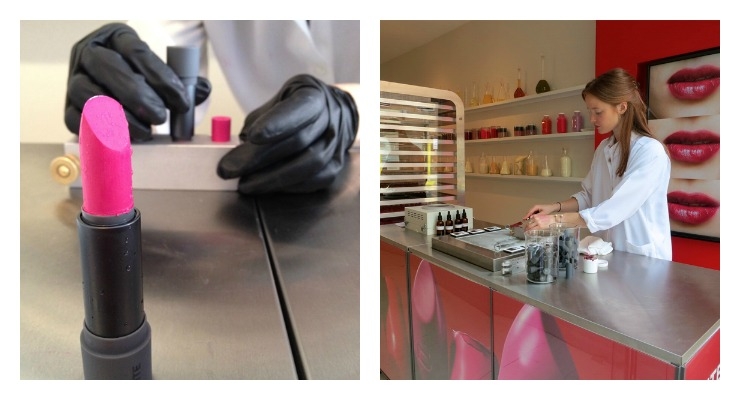Sophie Maxwell, Futures Director, Pearlfisher12.14.15
In a new era of more confident self-expression, our beauty has become a super-power—and

Sophie Maxwell
we have never had such a wealth of knowledge, experience and product available to us to suit our personal needs and changing styles.
This new future of beauty is undeniably being driven by the increasing power of personalization as a new generation of more radical beauty products and experiences emerge that are inspired and created by their consumers’ unique individuality.
Consumer-Centric Beauty Brands
These consumer-centric beauty brands are providing increasingly tailored experiences within the product composition—rather than as part of the messaging—to create an offer that is a perfect fit for their consumers.
NYC’s BITE Lip Lab (shown in the photos above) customizes lipstick to the consumer in store while new online ‘try-at-home’

Moda's App and Digital Imaging Device
fragrance retailer Pinrose uses an algorithm to analyze the answers to a series of questions in order to identify scents to appeal to the individual.
So what is driving this change?
Well, while personalization is not new news, the problem over the last decade lay with brands’ ability to implement it on a mass level and turn it into a true commercial opportunity rather than a niche service. But in recent years, the exponential growth in technological innovation has revolutionized this, moving us beyond luxurious ideals to create this real and dynamic change at a product level.
More Innovation
Innovations like Grace Choi’s Mink and MODA, by innovative Swedish beauty company FOREO, are now showing radical new approaches to a previously formulaic category where there was huge competition at a surface level between brands, but not in the fundamental approach to the products’ format, their application and ritual.

Geneu's DNA kit
These two brands are some of the first to reconsider the whole experience. MODA uses a smartphone app to help select our ideal beauty looks and then real-time digital application to apply and “print” make-up directly onto the user’s face, while Mink is the world’s first printer that prints a desired color directly onto a base, color-less product. Mink can instantly transform any image into a wearable color cosmetic and turn any phone, camera or laptop into an endless beauty aisle.
Tailored To Our Genes
We will also see brands go to the next and, some might say, final frontier as they create products tailored specifically to our genes.
The beauty sector is showing great advances in harnessing our DNA to create a new standard for efficacious skin care. Premium skin care brand Geneu (Gene You) produces bespoke monthly doses of serum tailor-made to an individual’s DNA.
In the same vein, beauty giant L’Oreal, recently announced a research partnership with Organovo to develop 3D printed human skin tissue, which speaks to future innovation opportunities in both beauty and health.
The Opportunity
As the tech and beauty industries continue to converge and probe the opportunities in personalization, brands need to remember that future consumers will be increasingly educated, empowered and confident. They are taking control of their beauty and wellbeing and are demanding knowledge and smart systems they can interact with.
The resulting opportunity for brands is to find new ways to be increasingly creative and collaborative, creating the future with—not just for—their consumers.
ABOUT THE AUTHOR
Sophie Maxwell
This new future of beauty is undeniably being driven by the increasing power of personalization as a new generation of more radical beauty products and experiences emerge that are inspired and created by their consumers’ unique individuality.
Consumer-Centric Beauty Brands
These consumer-centric beauty brands are providing increasingly tailored experiences within the product composition—rather than as part of the messaging—to create an offer that is a perfect fit for their consumers.
NYC’s BITE Lip Lab (shown in the photos above) customizes lipstick to the consumer in store while new online ‘try-at-home’
Moda's App and Digital Imaging Device
So what is driving this change?
Well, while personalization is not new news, the problem over the last decade lay with brands’ ability to implement it on a mass level and turn it into a true commercial opportunity rather than a niche service. But in recent years, the exponential growth in technological innovation has revolutionized this, moving us beyond luxurious ideals to create this real and dynamic change at a product level.
More Innovation
Innovations like Grace Choi’s Mink and MODA, by innovative Swedish beauty company FOREO, are now showing radical new approaches to a previously formulaic category where there was huge competition at a surface level between brands, but not in the fundamental approach to the products’ format, their application and ritual.
Geneu's DNA kit
Tailored To Our Genes
We will also see brands go to the next and, some might say, final frontier as they create products tailored specifically to our genes.
The beauty sector is showing great advances in harnessing our DNA to create a new standard for efficacious skin care. Premium skin care brand Geneu (Gene You) produces bespoke monthly doses of serum tailor-made to an individual’s DNA.
In the same vein, beauty giant L’Oreal, recently announced a research partnership with Organovo to develop 3D printed human skin tissue, which speaks to future innovation opportunities in both beauty and health.
The Opportunity
As the tech and beauty industries continue to converge and probe the opportunities in personalization, brands need to remember that future consumers will be increasingly educated, empowered and confident. They are taking control of their beauty and wellbeing and are demanding knowledge and smart systems they can interact with.
The resulting opportunity for brands is to find new ways to be increasingly creative and collaborative, creating the future with—not just for—their consumers.













